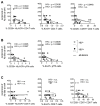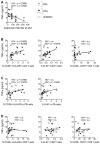Impaired antibody response to influenza vaccine in HIV-infected and uninfected aging women is associated with immune activation and inflammation
- PMID: 24236161
- PMCID: PMC3827419
- DOI: 10.1371/journal.pone.0079816
Impaired antibody response to influenza vaccine in HIV-infected and uninfected aging women is associated with immune activation and inflammation
Abstract
Background: Aging and HIV infection are independently associated with excessive immune activation and impaired immune responses to vaccines, but their relationships have not been examined.
Methods: For selecting an aging population we enrolled 28 post-menopausal women including 12 healthy volunteers and 16 HIV-infected women on antiretroviral treatment with <100 HIV RNA copies/ml. Antibody titers to trivalent influenza vaccination given during the 2011-2012 season were determined before and 4 weeks after vaccination.
Results: Seroprotective influenza antibody titers (≥ 1:40) were observed in 31% HIV(+) and 58% HIV-uninfected women pre-vaccination. Following vaccination, magnitude of antibody responses and frequency of seroprotection were lower in HIV(+) (75%) than in HIV(-) (91%) women. Plasma IL-21, the signature cytokine of T follicular helper cells (Tfh), and CD4 T cell IL-21R were upregulated with seroconversion (≥ 4 fold increase in antibody titer). Post-vaccine antibody responses were inversely correlated with pre-vaccination plasma TNFα levels and with activated CD4 T cells, including activated peripheral (p)Tfh. Plasma TNFα levels were correlated with activated pTfh cells (r=0.48, p=0.02), and inversely with the post-vaccination levels of plasma IL-21 (r=-0.53, p=0.02). In vitro TNFα blockade improved the ability of CD4 T cells to produce IL-21 and of B cells to secrete immunoglobulins, and addition of exogenous IL-21 to cell cultures enhanced B cell function. Higher frequencies of activated and exhausted CD8 T and B cells were noted in HIV(+) women, but these markers did not show a correlation with antibody responses.
Conclusions: In aging HIV-infected and uninfected women, activated CD4 and pTfh cells may compromise influenza vaccine-induced antibody response, for which a mechanism of TNFα-mediated impairment of pTfh-induced IL-21 secretion is postulated. Interventions aimed at reducing chronic inflammation and immune activation in aging, HIV-infected patients may improve their response to vaccines.
Conflict of interest statement
Figures






References
Publication types
MeSH terms
Substances
Grants and funding
LinkOut - more resources
Full Text Sources
Other Literature Sources
Medical
Research Materials

